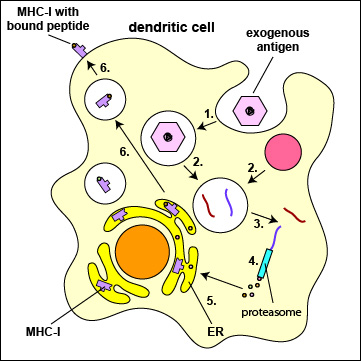
Exogenous antigens can be cross-presented to MHC-I molecules by certain dendritic cells. One proposed mechanism is via the translocation of proteins from the phagosome into the cytoplasm of the dendritic cell.
1. An exogenous antigen is engulfed and placed in a phagosome.
2. A lysosome fuses with the phagosome forming a phagolysosome.
3. Some proteins from the partially degraded exogenous antigen within the phagolysosome are translocated into the cytoplasm of the dendritic cell.
4. These proteins are then degraded into peptides by a proteasome.
5. The peptides enter the endoplasmic reticulum (ER) where they bind to MHC-I molecules.
6. The MHC-I/peptide complexes are then transported to the surface of the dendritic cell where they can be presented to naive T8-lymphocytes.
Last updated: August, 2019
Please send comments and inquiries to Dr.
Gary Kaiser